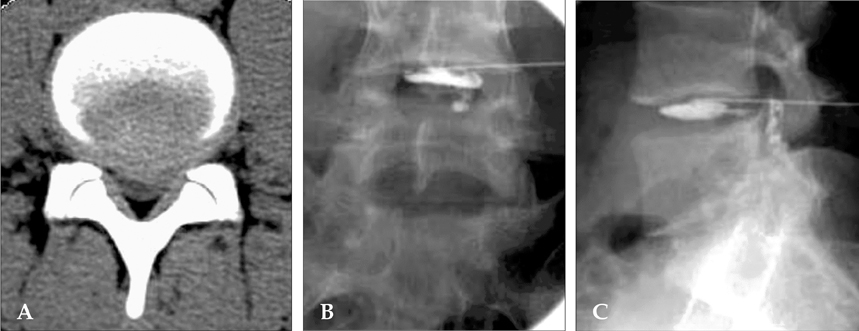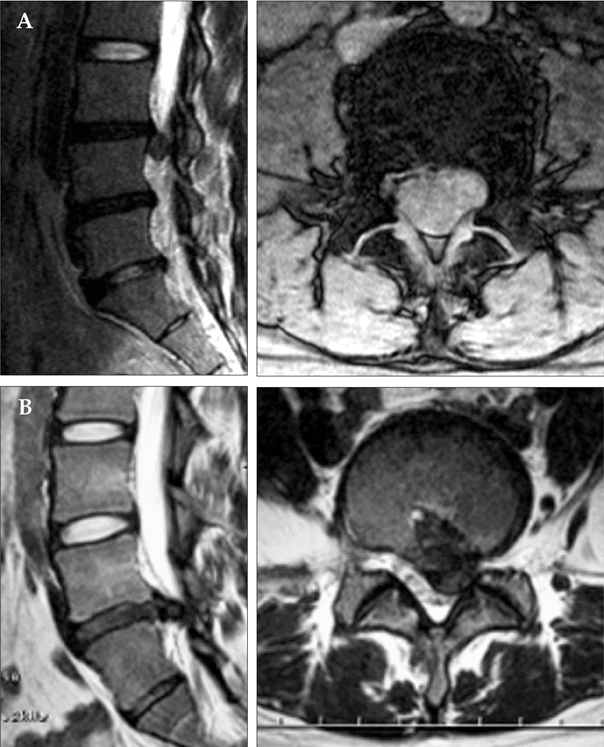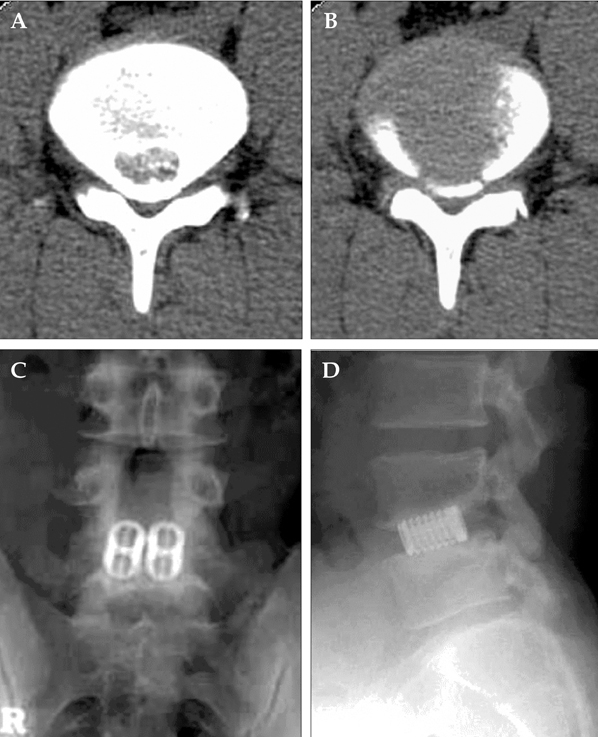Yonsei Med J.
2005 Feb;46(1):125-132. 10.3349/ymj.2005.46.1.125.
Surgical Treatments for Lumbar Disc Disease in Adolescent Patients; Chemonucleolysis / Microsurgical Discectomy/ PLIF with Cages
- Affiliations
-
- 1Department of Neurosurgery, Yonsei University College of Medicine, Seoul, Korea. kuhsu@yumc.yonsei.ac.kr
- 2Kwanghye Spine Center, Seoul, Korea.
- KMID: 2158122
- DOI: http://doi.org/10.3349/ymj.2005.46.1.125
Abstract
- The herniated lumbar disc (HLD) in adolescent patients is characterized by typical discogenic pain that originates from a soft herniated disc. It is frequently related to back trauma, and sometimes it is also combined with a degenerative process and a bony spur such as posterior Schmorl's node. Chemonucleolysis is an excellent minimally invasive treatment having these criteria: leg pain rather than back pain, severe limitation on the straight leg raising test (SLRT), and soft disc protrusion on computed tomography (CT). Microsurgical discectomy is useful in the cases of extruded or sequestered HLD and lateral recess stenosis due to bony spur because the nerve root is not decompressed with chymopapain. Spinal fusion, like as PLIF, should be considered in the cases of severe disc degeneration, instability, and stenosis due to posterior central bony spur. In our study, 185 adolescent patients, whose follow-up period was more than 1 year (the range was 1 - 4 years), underwent spinal surgery due to HLD from March, 1998 to December, 2002 at our institute. Among these cases, we performed chemonucleolysis in 65 cases, microsurgical discectomy in 94 cases, and posterior lumbar interbody fusion (PLIF) with cages in 33 cases including 7 reoperation cases. The clinical success rate was 91% for chemonucleolysis, 95% for microsurgical disectomy, and 89% for PLIF with cages, and there were no non- union cases for the PLIF patients with cages. In adolescent HLD, chemonucleolysis was the 1st choice of treatment because the soft adolescent HLD was effectively treated with chemonucleolysis, especially when the patient satisfied the chemonucleolysis indications.
Keyword
MeSH Terms
Figure
Reference
-
1. Epstein JA, Epstein NE, Marc J, Rosenthal AD, Lavine LS. Lumbar intervertebral disk herniation in teenage children: recognition and management of associated anomalies. Spine. 1984. 9:427–432.2. Ishihara H, Matsui H, Hirano N, Tsuji H. Lumbar intervertebral disc herniation in children less than 16 years of age. Long-term follow-up study of surgically managed cases. Spine. 1997. 22:2044–2049.3. Kim YS, Chin DK, Yoon DH, Jin BH, Cho YE. Predictors of successful outcome for lumbar chemonucleolysis: analysis of 3000 cases during the past 14 years. Neurosurgery. 2002. 51:123–128.4. Lorenz M, McCulloch J. Chemonucleolysis for herniated nucleus pulposus in adolescents. J Bone Joint Surg Am. 1985. 67:1402–1404.5. Martinez-Lage JF, Poza M, Arcas P. Avulsed lumbar vertebral rim plate in an adolescent: trauma or malformation? Child's Nerv Syst. 1998. 14:131–134.6. Parisini P, Di Silvestre M, Greggi T, Miglietta A, Paderni S. Lumbar disc excision in children and adolescents. Spine. 2001. 26:1997–2000.7. Bradbury N, Wilson LF, Mulholland RC. Adolescent disc protrusions. A long-term follow-up of surgery compared to chymopapain. Spine. 1996. 21:372–377.8. Lee JY, Ernestus RI, Schroder R, Klug N. Histological study of lumbar intervertebral disc herniation in adolescents. Acta Neurochir (Wien). 2000. 142:1107–1110.9. Clarke NM, Cleak DK. Intervertebral lumbar disc prolapse in children and adolescents. J Pediatr Orthop. 1983. 3:202–206.10. Van Alphen HA, Braakman R, Bezemer PD, Broere G, Berfelo MW. Chemonucleolysis versus discectomy: a randomized multicenter trial. J Neurosurg. 1989. 70:869–875.11. Javid MJ. Chemonucleolysis versus laminectomy. A cohort comparison of effectiveness and charges. Spine. 1995. 20:2016–2022.12. Bayliss MT, Jonestone B, O'Brien JP. Proteoglycan synthesis in the human intervertebral disc, Variation with age, region and pathology. Spine. 1988. 13:972–981.
- Full Text Links
- Actions
-
Cited
- CITED
-
- Close
- Share
- Similar articles
-
- The Comparative Study of Chemonucleolysis and Percutaneous Lumbar Discectomy for Lumbar Disc Herniation
- Indirect decompression as a minimally invasive spine surgery
- Microsurgery for Lumbar Disc Disease
- Minimaly Invasive Spinal Surgery: Cinical analysis of Chemonucleolysis & Percutaneous Automated Lumbar Discectomy
- Chemonucleolysis Versus Percutaneous Automated Discectomy Using Nucleotome




